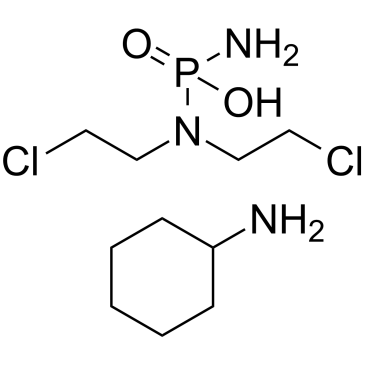Phosphoramide mustard (cyclohexanamine) (Synonyms: NSC 69945, PMC) |
| Catalog No.GC61182 |
An alkylating agent and active metabolite of cyclophosphamide
Products are for research use only. Not for human use. We do not sell to patients.

Cas No.: 1566-15-0
Sample solution is provided at 25 µL, 10mM.
Phosphoramide mustard cyclohexanamine is the major metabolite for Cyclophosphamide , with anticancer activitiy. Phosphoramide mustard cyclohexanamine induces DNA adduct formation in ovarian granulosa cells, induces DNA damage and elicits the ovarian DNA repair response[1][2].
Phosphoramide mustard cyclohexanamine causes cytotoxicity through forming cross-linked DNA adducts which inhibit DNA strand separation during replication[1].Phosphoramide mustard cyclohexanamine destroys rapidly dividing cells by forming NOR-G-OH, NOR-G and G-NOR-G adducts with DNA, potentially leading to DNA damage[1].Phosphoramide mustard cyclohexanamine (3-6 μM; 48 hours) reduces cell viability in rat spontaneously immortalized granulosa cells (SIGCs)[1].Phosphoramide mustard cyclohexanamine (3-6 μM; 24-48 hours) induces DNA adduct formation[1].Phosphoramide mustard cyclohexanamine (3-6 μM; 24-48 hours) induces ovarian DNA damage in rat ovaries[1].Phosphoramide mustard cyclohexanamine increases DNA damage responses (DDR) gene (Atm, Parp1, Prkdc, Xrcc6, Brca1, Rad51) mRNA expression level[1].Phosphoramide mustard cyclohexanamine (3-6 μM; 24-48 hours) increased DDR proteins[1]. Cell Viability Assay[1] Cell Line: SIGCs
Phosphoramide mustard cyclohexanamine (2.1-20.7 mg/kg; i.p.; daily; for 5 days) inhibits subcutaneous tumor growth in rats[2].Phosphoramide mustard cyclohexanamine (86.0 mg/kg; i.v.) has a plasma disappearance half-life of 15.1 minutes[2]. Animal Model: Rat, subcutaneously implanted Walker 256 carcinosarcoma tumor[2]
[1]. Shanthi Ganesan, et al. Phosphoramide mustard exposure induces DNA adduct formation and the DNA damage repair response in rat ovarian granulosa cells. Toxicol Appl Pharmacol. 2015 Feb 1; 282(3): 252-258. [2]. S Genka, et al. Brain and plasma pharmacokinetics and anticancer activities of cyclophosphamide and phosphoramide mustard in the rat. Cancer Chemother Pharmacol. 1990;27(1):1-7.
Average Rating: 5 (Based on Reviews and 26 reference(s) in Google Scholar.)
GLPBIO products are for RESEARCH USE ONLY. Please make sure your review or question is research based.
Required fields are marked with *




















